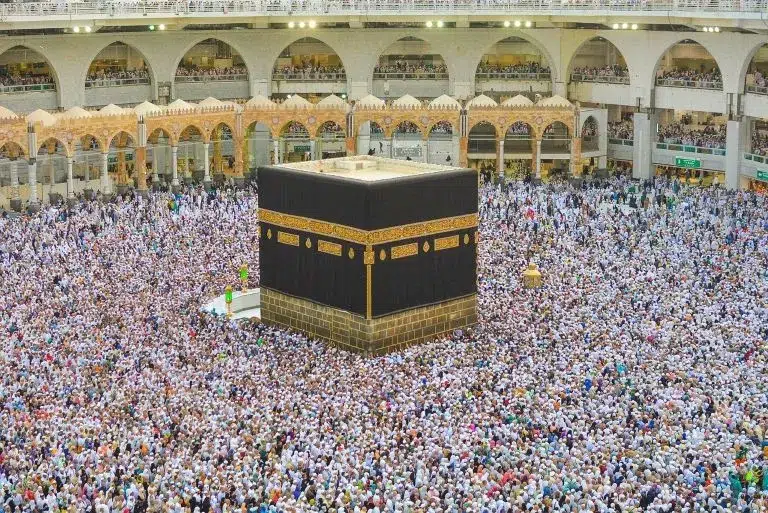Introduction
As Muslims, we have great respect for our sacred places and relics, as they play a crucial role in our faith. The Kaaba in Mecca is our most revered structure and holiest site. The Black Stone, known as Hajr e Aswad, is located in its eastern corner and is held in great affection by all Muslims.
For more information about the Kaaba, you can visit the blog.
The Black Stone is highly significant in Islam. It is not simply a stone but a symbol of our spiritual journey and connection to Allah (SWT). When we visit Mecca for the Hajj or Umrah, kissing or touching the Black Stone represents a moment of purification rather than just a ritual.
For more information, visit our blog, What is Umrah?
If you’re looking for detailed and comprehensive information on the Hajj and Umrah, including the interesting history of the sacred pilgrimages, practical tips, and step-by-step instructions for performing each ritual, our comprehensive category, Hajj and Umrah, provides a complete guide to understanding the importance of the spiritual experience. We’ve included everything you need to know to make the most of your journey. Additionally, we’ve compiled a list of essential duas that can be helpful in your pilgrimage and Umrah.
History and Origins of the Hajr e Aswad
The history of the Hajr-e-Aswad is deeply rooted in the Islamic faith, tracing back to the time of Hazrat Ibrahim (AS). According to Islamic traditions, Allah (SWT) instructed Hazrat Ibrahim (AS) to construct the Kaaba, the holiest site in Islam. The stone served as a gift from heaven, symbolizing the covenant and faith between Allah (SWT and Hazrat Ibrahim (AS).
For more information about heaven, visit this blog post: Jannah – The Reward for True Muslims.
Originally, the stone was white, but as humanity’s sins accumulated over time, it turned black. This transformation is believed to be symbolic, reflecting the concept that the stone absorbed the sins of the pilgrims who touched it.
Hazrat Abbas (RA) narrated that:
The Messenger of Allah (SAW) said: “The Black Stone descended from the Paradise, and it was more white than milk, then it was blackened by the sins of the children of Adam.”
(Jami at-Tirmidhi 877)
This Hadith highlights the importance of repentance for sins and the significance of the Hajr-e-Aswad in the Islamic faith.
The Black Stone’s Placement in the Kaaba
Islamic belief states that Allah (SWT) commanded Hazrat Ibrahim (AS) and his son Ismail (AS) to construct the Kaaba. During the construction, they encountered a difficult situation where a stone was missing, and they could not complete the structure. According to Islamic tradition, the Angel Jibreel (Gabriel) brought the Hajar al-Aswad from heaven to fill this gap. This black stone is now situated in the eastern corner of the Kaaba and holds great importance for Muslims worldwide.
Centuries after the reconstruction of the Kaaba, before the prophethood of Hazrat Muhammad (SAW), an issue involving the placement of Black Stone arose. During this time, there was a disagreement among the clans of the Quraysh crew regarding who would have the honor of placing the Black Stone back into the wall of the Kaaba.
To avoid bloodshed, the clans agreed that the next person to enter the sanctuary would decide. Prophet Muhammad (SAW) entered the sanctuary but was not yet a Prophet. He proposed a solution that involved all the disputing clans. The stone was placed on a cloth, and each clan leader held a corner of the cloth to lift the stone. Prophet Muhammad (SAW) placed the stone into the wall, resolving the conflict peacefully.
Hajr e Aswad in Quran and Hadith
Although the Quran doesn’t explicitly mention it or the act of kissing it, the Hadith literature sheds light on the practices and teachings of Prophet Muhammad (SAW) regarding this revered stone.
Narrated by Hazrat Abis bin Rabia (RA):
Hazrat Umar (RA) came near the Black Stone and kissed it and said “No doubt, I know that you are a stone and can neither benefit anyone nor harm anyone. Had I not seen Allah’s Messenger (SAW) kissing you I would not have kissed you.”
[Sahih al-Bukhari 1597]
Kissing the Hajr e Aswad is considered a Sunnah. Pilgrims perform this act during their circumambulation of the Kaaba. This practice highlights the strong connection between the rituals of Hajj and the example set by Hazrat Muhammad (SAW).
The Act of Kissing the Hajr e Aswad During Tawaf
Kissing or touching the Hajr e Aswad is an important ritual for Muslims who perform Hajj or Umrah. As mentioned above, this act is considered the Sunnah of Prophet Muhammad (PBUH). As during his Tawaf, the Prophet (SAW) used to kiss the stone, and this practice has been passed down through generations of Muslims.
For more information about Tawaf, visit this blog post: Tawaf in Hajj and Umrah: Significance and Method.
However, it is important to note that kissing the stone is not obligatory; it is recommended. If you cannot reach the stone due to crowding, you can perform a symbolic kissing gesture without touching it. Therefore, you can kiss your hand and raise it towards the stone to show respect.
A Journey Through Time: Other Events Related to the Hajr e Aswad
One of the most noteworthy events associated with the Hajr-e-Aswad is its theft from the Kaaba. According to historical accounts, the Black Stone was stolen in 930 CE by the Qarmatians, a radical sect that operated in Eastern Arabia. The Qarmatians attacked Mecca, ransacked the Kaaba, and took the Black Stone to their stronghold in the Eastern Arabian Peninsula.
After 22 years, the Qarmatians finally returned the Black Stone to Mecca. They left it at the entrance of the Kaaba, wrapped in a sack, as a sign of their intention to return it. However, they caused considerable damage to the stone during its absence.
Hajr-e-Aswad is fragmented due to the damage inflicted upon it during its theft and subsequent return. It is covered in a protective silver casing, which holds the fragments together. Despite its fragmented state, the Hajr-e-Aswad remains a focal point of reverence. It continues to inspire devotion among Muslims performing the pilgrimage rituals at the Kaaba.
Respectful Conduct and Avoiding Misconceptions
When discussing the Hajr e Aswad, it is essential to treat it with the highest possible respect and consider it a sacred relic, not an idol. This is because the stone holds immense religious importance for Muslims worldwide.
A straight line extending from the Hajr e Aswad determines the starting and ending points of the Tawaf. Additionally, it’s important to address any misconceptions about the worship of the stone. Some people may mistakenly believe that Muslims worship the Hajr e Aswad itself rather than using it as a focal point during their prayers. It’s important to clarify that this is not the case and that the stone serves as a symbol of the unity of the Muslim community and a reminder of the divine unity of Allah (SWT). By underlining these points, we can ensure that respectful conduct is maintained and that any misunderstandings are avoided.
Conclusion
The Hajr e Aswad is mysterious and significant in Islamic history and pilgrimage. It symbolizes Muslims faith and devotion to Allah (SWT). As we reflect on its importance, let’s motivate each other to perform Tawaf with utmost reverence and respect for the traditions associated with the Black Stone. By doing so, we can deepen our understanding and strengthen our connection with our faith.









